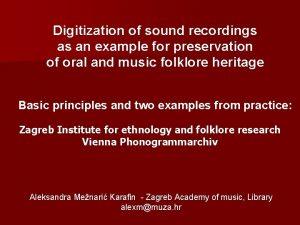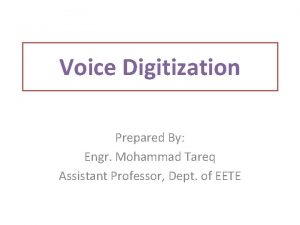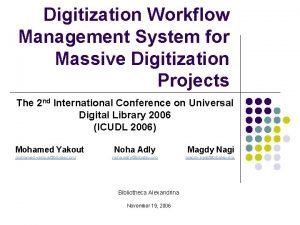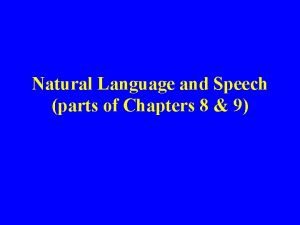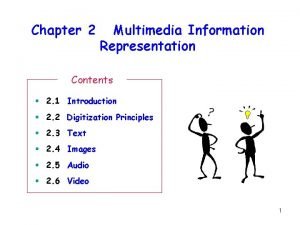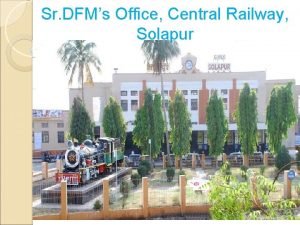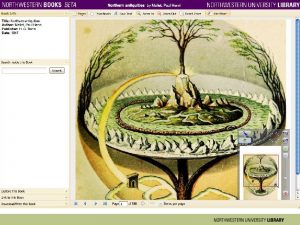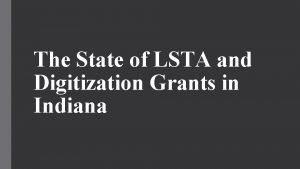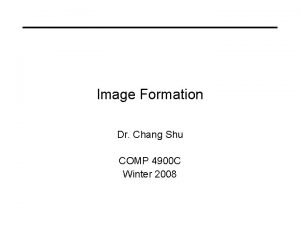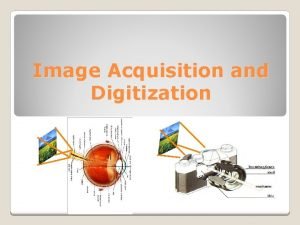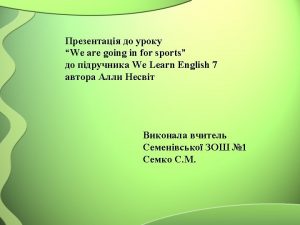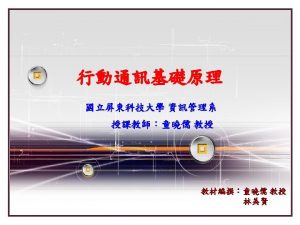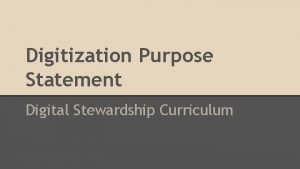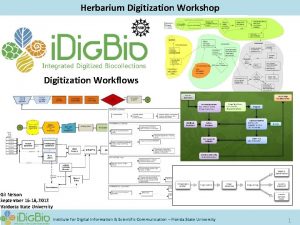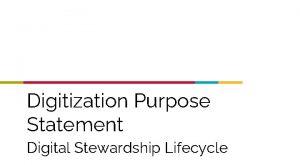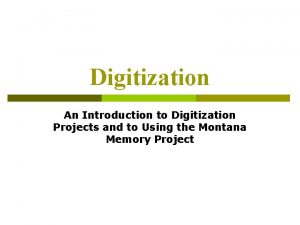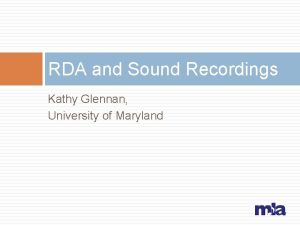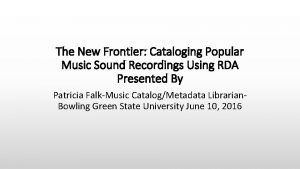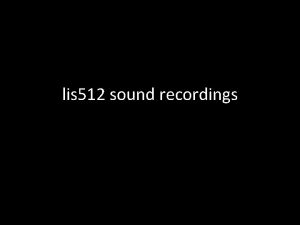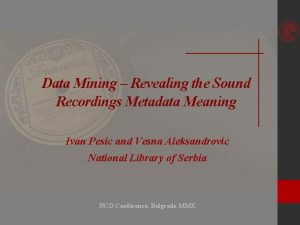Digitization of sound recordings as an example for









































- Slides: 41

Digitization of sound recordings as an example for preservation of oral and music folklore heritage Basic principles and two examples from practice: Zagreb Institute for ethnology and folklore research Vienna Phonogrammarchiv Aleksandra Mežnarić Karafin - Zagreb Academy of music, Library alexm@muza. hr

Sound recordings are unique witnesses of human social and cultural history starting fom the end of 19 th century • They can preserve: üspeeches, lectures, interviews ümusical / speech performances ümusical and oral folklore traditions • They have great documentary value • They are essential in scentific studies that require field research – linguistics, anthropology, folklore research

Folklore: • communication process embodied in orally transmitted forms of cultural expression of all segmets of society Recordings from field research are irreplaceable: • they contain spontaneous, unrepeatable elements which could not be documented and preserved in written notes • large quantities of filed recordings on endangered carrier – wax cylinders, steel wire, analog magnetic tape • their significance is not always recognized • projects: TAPE, PRESTO, UNESCO Memory of the world program, U. S. Congress National Recording Preservation Act (2000)

Development of the sound recording techniques: • begun with Edison’s invention of the phonograph in 1877 • improved, portable version of the phonograph vas introduced in 1880 (recording media - wax cylinder) • influenced the scope, focus and methods of the field research of traditional culture, also in linguistics, anthropology, zoology. . .

First phonograph field recordings: • 1890 J. W. Fawkes, ethnologist • 1901 Milan Rešetar, linguist (Slavic languages research for Phonogrammarchiv) • B. Bártok i Z. Kodály – recordings of traditional music of Hungary and Rumania • in the period of 1920 -1930 – B. Širola and M. Gavazzi – recordings form Kotoriba (Međimurje) – original cylinders stored in Phonogrammarchiv

Magnetic recording technique • basic principles yet in 1878 (O. Smith), perfected during the World War II • sound carrier evolved fom steel wire into magnetic tape • widely spread in the fifties - transporatble recording units with bateries – important for the filedwork

• in Vienna Phonogrammarchiv introduced in 1951, fom 1954 portable recorders in field research • first recordings for IEF in 1954 – ethnomusicologist Vinko Žganec, filed trip to Međimurje • analogue magnetic tape recording remained primary field recording tecnique by the eighties (when digital recording technology was perfected)

Result : • large collections of deteriorating sound recordings – in archives, research institutions all over the world Significance: • witnesses of the wanishing traditions • of the turbulent social and cultural changes • focus of the scientific research of home institutions

Preservation problems: • rapid alteration of inovation and obsolescence in every aspect of the sound recording, reproduction and storage (new media, obsolete reproduction equipment, no expert personal) • sound carriers have shorter life expectance than the traditional printed material – unstable base materials, more subject to damage caused by inadequate handling, storage and replay equipment

To hear those recordings we need: • physical carrier in good condition – magnetic tapes are considered endangered storage media (specially acetate base ones) • available and functional reproduction equipment – magnetic tape players are almost obsolete • knowledge of how to handle that equipment, of sound / recording format /speed (user need special knowledge and experience to safely handle an open reel magnetic tape)

How to preserve sound recording on the carrier endangered by inevitable deterioration: • transfer the recording on to new media, or, • convert the recording to a new format Approaches: • in the last decade of 20 th century expert associations (AES, NARA, ARSC) still concerned about use of digital recording technology and digital storage media for long-term preservation • for preservation and storage of sound recordings they recommend re-recording of endangered materials on analogue magnetic tapes

Ch. A. Paton (1998) reasons against digital technology: • rapid change /improvement of the technology – rapid obsolescence of hardware, digital format and storage media • lack of consensus regarding sample rate, bit depth and record format for sound archiving • questionable stability and durability of the storage media A. Smith (1999): • digitization is primarily a method of providing access to rare, endangered, or distance materials – not permanent solution for preservation

E. Cohen (2001) – “distribution is preservation”-relays on the possibilities that lay in digital domain and networked environment: • creating an unlimited number of identical copies without the loss of original information • simple distribution of the documents • web access • permanent, media independent preservation of digital content • “Urgent conversion of analogue recordings into digital domain is an imperative – to hesitate means to compromise preservation”

Important: Preservation of original carriers and original replay equipment is of same importance: future development of sound reproduction technology could enable the transfer of yet unavailable subtle sound contetnt

Analogue sound recording digitization standards – basic documents: • IFLA Guidelines for digitization projects (2002) • IASA – Technical Committee Standards IASA-TC 03 (2005) - The Safeguarding of the Audio Heritage: Ethics, Principles and Preservation Strategy • IASA-TC 04 (2004) – Guidelines on the Production and Preservation of Digital Audio bjects • IASA Task force to establish selection criteria of analogue and digital audio content for transfer to data formats for preservation purposes (2003)

Reasons for digitization: • saving original sound content from endangered carrier / protection of the original carrier • easy access – replay equipment for magnetic tapes became obsolete, complicated for handling, incompetent user can cause damage to the tape • providing new services / attracting new users

Basic selection criteria – IFLA Guidelines: • Content: intellectual value of materials, their historical, scientific and cultural significance – unique sources must have priority • Demand: priority is given to materials in constant demand • Condition: fragile and damaged unique materials – restoration procedures may be needed before the transfer

Priorities - analogue sound recordings (IASA_TC 03): • documents in immediate risk / recordings on endangered media • documents who are part of an obsolete or commercially unsupported system • documents in regular demand

Transfer of analogue recordings: • for optimal transfer of analogue recording maximum fidelity during the reproduction of the original must be ensured • expert knowledge of original format is required • availability and optimal adjustment of well maintained and completely functional replay equipment

Preparation procedures: • Checking, preparation and cleaning of the original tape (identification of the tape, establishing tape condition, eventual damage repair) • Configuration and calibration of replay equipment (tape speed setting, defining recording format /monostereo/ and equalization standards, . . . ) • Data about original tapes, restoration procedures, replay and transfer parameters must be documented for the future reference!

Sound recording digitization standards according to IASA-TC 03: • sampling frequency / bit rate - 96 k. Hz /24 bit - archival sound record standard • user copy – CD-Audio quality (44, 1 k. Hz/16 bit) • data reduction (MP 3) if needed (network transfer) • unmodified transfer – analogue signal should be transferred without modifications – unintended sound artifacts are important part of sound document

Sound record format for sound archiving: • widely accepted formats should be chosen • should support high resolution audio records • should be transparent – simple coding schemes (PCM), without data reduction • should have enclosed metadata about data extraction procedures

IASA-TC 03 recommends: • WAVE (. wav) • Broadcast Wave Format (. bwf) • Audio Interchange File Format (. aiff), • PCM or LPCM coding schemes ð MP 3 only for access copies or web streaming – not appropriate for long-term preservation!

Principles of digital sound archiving (IASA-TC 03): • each digital copy must be free of uncorrectable errors • each carrier must be regularly checked for data integrity • digital content must be copied before: üuncorrectable errors occur (refreshment) ücarriers, formats, hardware becomes obsolete (migration) • at least two preservation copies • additional access copies – should not be kept in the same location as preservation copies

Digital storage media: • magnetic and optical media • lifetime and stability depending on conditions of their use and storage • subject to hardware and format obsolescence • mostly used: R-DAT, CD-R, DLT and LTO magnetic tapes • R-DAT – considered obsolete • raising concern about use of CD-R and DVD as digital target formats for archives • rapid changes in storage media, format, hardware and software

Solution for long term preservation: repositories based on OAIS model, or Digital Mass Storage System (DMSS) • automated, media independent approach • automated systems for storage, management, maintaining and integrity check of digital data, • preservation and distribution of digital objects with embedded metadata • large financial investments needed – out of reach to smaller institutions and archives

Metadata • indispensable for finding, control and usage of digital documents • descript ional, administrative and structural metadata • preservation metadata mandatory at assessment of technical parameters of the recording – data about original carrier, format and preservation, reproduction equipment and its parameters • data about digital format, resolution • most used – MARC bibliographic record and Dublin Core Metadata Element Set • standalone / embedded (Standard Generalized Markup Language)

Institute for ethnology and folklore research: • sound recording collection is a part of Documentation collection – documents are result of scientific research activities of IEF – since 1948 • unique documents regarding Croatian traditional culture of 20 th century, culture of other nationalities in Croatia and Croats abroad • from 1991 status of cultural monument “ 0” and “I” category • sound recording collection – 3300 magnetic tapes (PVC based) – 4000 hours of recorded material

• in the nineties, during the war tapes stored in the cellar of old building where IEF was located • in 1995. first signs of deterioration were discovered (mould) • after consultation with audio engineer of Croatian radio and Samofix company digitization - transfer of recordings from magnetic tapes to audio CD was initiated • never defined as a official project

Project objectives (Samofix d. o. o. proposal): • to make recordings available for a larger number of users • easier browsing thru CD content • technical make-up – to increase quality of the recordings, and to make them “clearer” • choice of storage media (CD-R) based on its wide acceptance, practical use, and then still unconfirmed assumptions about its durability and life expectancy

• • • restoration procedures were not documented, neither procedures of “cleaning of sound content” and “removal of useless situations” restoration procedures, transfer of original recordings, choice of digital resolution and digital record storage media defined only in Samofix d. o. o. project proposal (1996) in nine years recordings from 521 tape were transferred to 659 CD-s digital record resolution 44 k. Hz/ 16 bit audio CD. cda digital sound format two identical copies – archival / user, stored in the same place as the tapes

Basic description in computer database (File Maker Pro): • data about author of recording, location, year, title broadly defines the content, and detailed list of recorded content • no information about original tape, recording equipment, transfer procedures • not based on any accepted metadata scheme

Digitization of sound collection: • carried out with difficulties in financing – partially IEF, and Ministry of culture (until 2003) • one of the first in this part of Europe • some solutions are problematic in long-term • in Croatia – important, ground-braking initiative of small unprofitable cultural institution • in the future – necessary to revise current basic principles according to internationally accepted standards

Phonogrammarchiv of Austrian Academy of Sciences • the oldest sound archive in the world (1899), significant Historic collection • sound collection has 43074 recordings on magnetic tapes (acetate, PVC, polyester) • tapes generally in good condition, fully functional reproduction equipment • digitization started in 1995 – tapes first converted to RDAT • systematic digitization begun in year 2000, according to IASA-TC 04

• archive digitizes parts of its one collection, and collections of other archives and institutions (Quellmalz collection, 2007, Memory of the world Program) • from the beginning digital resolution of 96 k. Hz/ 24 bit was used, • WAVE (. wav) sound record format original sound record was not modified in any way – digital copy is real copy of the original •

• physical restoration of the tapes, when needed • archival sound record and complete additional documentation stored in two identical copies on LTO 3 magnetic tapes • for storing, access and manipulation – combination of server, LTO Juke Box and manual manipulation is used • user copies available online in MP 3 format • metadata: Dublin Core Metadata Element Set, supplemented by IASA cataloguing rules

Conclusion: • digitization of field recordings on analogue magnetic tapes - preservation of valuable folklore heritage • value of sound recordings internationally recognized U. S. Congress National Recording Preservation Act (2000) • Projects (TAPE, PRESTO, UNESCO Memory of the world program) • standards defined by IFLA, IASA, AES

• field recordings as an example of material with specific function and documentary value • only a small part of comprehensive sound heritage • in Croatia – problem is neglected, interest in sound recordings preservation only recently • without change in approach – because lack of interest and knowledge significant part of cultural heritage will be irreversibly lost

IEF and Phonogrammarchiv: In common: • scientific research of folklore an significant collections of filed recordings on magnetic tapes Different: • primary function and priorities, staff profile, technical equipment and financial possibilities

Result of digitization IEF • easy access, preservation of original tape, but not completely original, unmodified sound information • undocumented modifications – questionable fidelity of digital record Phonogrammarchiv • preserved original sound documents • expert standards were followed in all aspects of digitization process • ideal conditions for conducting complex digitization projects

Steps for action: • encourage persons on responsible positions in institutions who collect this material to recognize its value as a part of cultural heritage • educating experts in the field of preservation and archiving of sound materials • defining projects according to international standards and recommendations • ensuring financial support from responsible state administrative bodies, international projects and programs
 Digitization of sound
Digitization of sound Digital receptionist freepbx
Digital receptionist freepbx Color halsey
Color halsey Voice digitization
Voice digitization Digitization workflow
Digitization workflow Speech digitization and generation in hci
Speech digitization and generation in hci Global trade digitization
Global trade digitization Introduction to digitization
Introduction to digitization Digitization principles in multimedia
Digitization principles in multimedia E sr digitization
E sr digitization Digitization workflow diagram
Digitization workflow diagram Digitization in indiana
Digitization in indiana Comp 4900
Comp 4900 Image acquisition and digitization
Image acquisition and digitization Ddo template guidelines
Ddo template guidelines “a sound mind is in a sound body”
“a sound mind is in a sound body” Speed of sound through steel
Speed of sound through steel Fspos vägledning för kontinuitetshantering
Fspos vägledning för kontinuitetshantering Typiska novell drag
Typiska novell drag Tack för att ni lyssnade bild
Tack för att ni lyssnade bild Ekologiskt fotavtryck
Ekologiskt fotavtryck Shingelfrisyren
Shingelfrisyren En lathund för arbete med kontinuitetshantering
En lathund för arbete med kontinuitetshantering Kassaregister ideell förening
Kassaregister ideell förening Tidbok
Tidbok Anatomi organ reproduksi
Anatomi organ reproduksi Vad är densitet
Vad är densitet Datorkunskap för nybörjare
Datorkunskap för nybörjare Stig kerman
Stig kerman Debattinlägg mall
Debattinlägg mall För och nackdelar med firo
För och nackdelar med firo Nyckelkompetenser för livslångt lärande
Nyckelkompetenser för livslångt lärande Påbyggnader för flakfordon
Påbyggnader för flakfordon Lufttryck formel
Lufttryck formel Svenskt ramverk för digital samverkan
Svenskt ramverk för digital samverkan Urban torhamn
Urban torhamn Presentera för publik crossboss
Presentera för publik crossboss Argument för teckenspråk som minoritetsspråk
Argument för teckenspråk som minoritetsspråk Kanaans land
Kanaans land Treserva lathund
Treserva lathund Epiteltyper
Epiteltyper Claes martinsson
Claes martinsson
